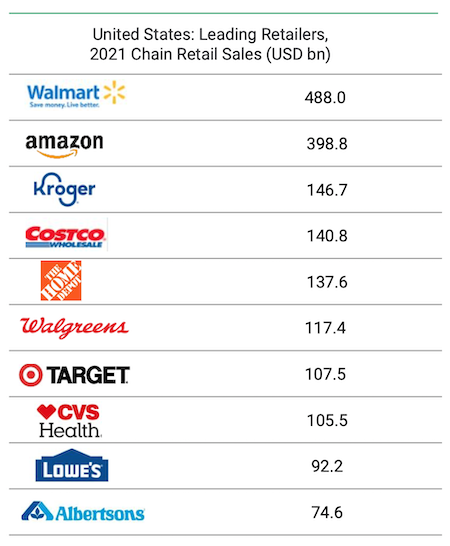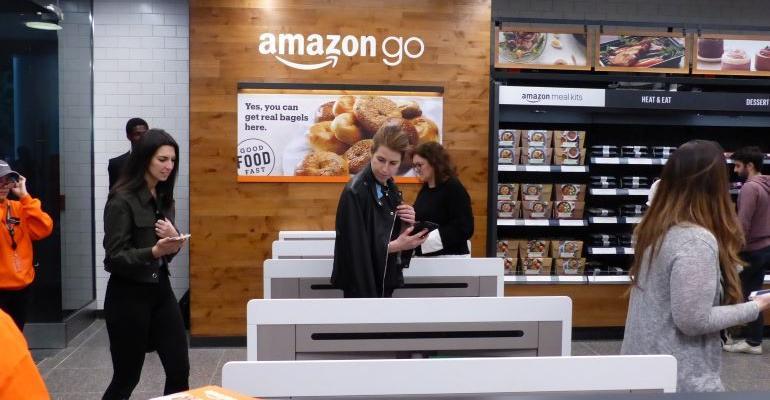Amazon will surpass Walmart as the largest U.S. retailer by 2024, as the online channel ramps up its share of overall retail sales dollars, CPG market researcher Edge by Ascential predicts.
Between 2021 and 2026, Amazon stands to add more than $294 billion in U.S. sales and grow its U.S. retail market share from 10.8% to 14.9%, whereas Walmart’s share will shrink from 13.2% to 12.7%, Boston-based Edge by Ascential forecast in its “2022 United States Retail Landscape and Go-to-Market Planning Report,” released yesterday. Sales figures are calculated using gross merchandise value (GMV).
 Overall North American chain retail sales came in at $3.69 trillion in 2021, including $837.5 billion in grocery sales. (Image courtesy of Edge by Ascential)
Overall North American chain retail sales came in at $3.69 trillion in 2021, including $837.5 billion in grocery sales. (Image courtesy of Edge by Ascential)
Walmart ($488 billion) and (Amazon $398.8 billion) were far and away the biggest U.S. chain retailers by 2021 sales, followed by The Kroger Co. ($146.7 billion) and Costco Wholesale ($140.8 billion), according to Edge by Ascential. Rounding out the top 10 were The Home Depot ($137.6 billion), Walgreens ($117.4 billion), Target ($107.5 billion), CVS Health ($105.5 billion), Lowe’s ($92.2 billion) and Albertsons Cos. ($74.6 billion).
Amazon leads with an estimated five-year compound annual growth rate (CAGR) of 11.7% in chain retail sales for the 2021-26 period, well above the next-closest retailer in CAGR — Costco — at 7.8%. Coming after those companies by five-year CAGR were Home Depot (5.5%), Target (4.8%), Walgreens (4.6%), Walmart (3.5%), Kroger (3.3%), CVS (3.1%), Lowe’s (2.7%) and Albertsons (1.6%).
Of the top six retailers besides Walmart and Amazon, companies projected to grow their share of chain retail sales during the 2021-26 period include Costco (from 3.8% to 4.4%) and Home Depot (from 3.7% to 3.9%), Edge by Ascential’s study said. Walgreens’ share is expected to remain at 3.2% and Kroger’s to dip from 4% to 3.7%.
Retailers in the food, drug and mass retail channel will get less of a lift from online grocery going forward after the pandemic-triggered sales boom in 2020-21, Edge by Ascential noted.
The U.S. e-grocery market is slated to add $34.7 billion from 2021 to 2026. Last year, online edible grocery sales totaled $54.8 billion, up 117% from 2019, before the pandemic. Walmart, Target, Kroger and Costco accounted for about half of U.S. online edible grocery penetration in 2021, which is expected to edge up from 6.5% to 8.8% by 2026. At the same time, online grocery’s five-year CAGR is forecast to drop from 38.9% in 2021 to 10.3% in 2026.
“Inflationary pressures continue to cut into retailer margins, both in the U.S. and abroad, while rising labor rates, increased material costs and higher fuel prices across all supply chains impact suppliers, retailers and consumers,” Deren Baker, CEO of Edge by Ascential, said in a statement. “Despite these challenges, data from Edge by Ascential shows that e-commerce will continue to be the largest driver of retail growth over the next few years in the U.S. and worldwide.”
Indeed, e-commerce continues be the chief retail growth catalyst, the report noted. In 2021, U.S. online sales rose 15.2% to $907.7 billion from $787 billion in 2020, twice the growth of overall retail sales, which climbed 7.6% last year. The overall online channel is expected to surmount $1 trillion by the end of 2022 and, by 2026, represent 30.5% of total retail sales, up from 24.6% in 2021, making the United States the second-largest global e-commerce market after China.
“Amazon has always taken advantage of its head start as a digital-first platform and has been a pioneer of almost all the growth levers associated with platform-based retail from ‘subscribe and save’ through Prime membership to the evolving media and marketing services Amazon offers to brands,” Baker added. “Therefore, it’s not a huge surprise that by gross merchandise value sales, our AI-powered forecasting software on Edge Retail Insight anticipates Amazon to overtake Walmart as the largest retailer in the U.S. by 2024.”
Edge by Ascential projects total chain retail share growth only in the e-commerce (24.6% to 30.5%) and cash-and-carry/club (6.2% to 6.5%) from 2021 to 2026. Retail channels predicted to see declines in that time span include supermarkets (13.8% to 12.4%), hyperstores (12.5% to 11.3%), pharmacy/health (6.7% to 6.2%), foodservice (6.4% to 5.8%), discount (4.0% to 3.9%) and convenience (2.7% to 2.5%).
Total North American chain retail sales came in at $3.69 trillion in 2021, including $907.7 billion in e-commerce sales (24.6% penetration) and $837.5 billion in grocery sales, Edge by Ascential reported. Chain sales accounted for 95% of food retail and 95% of overall retail.





